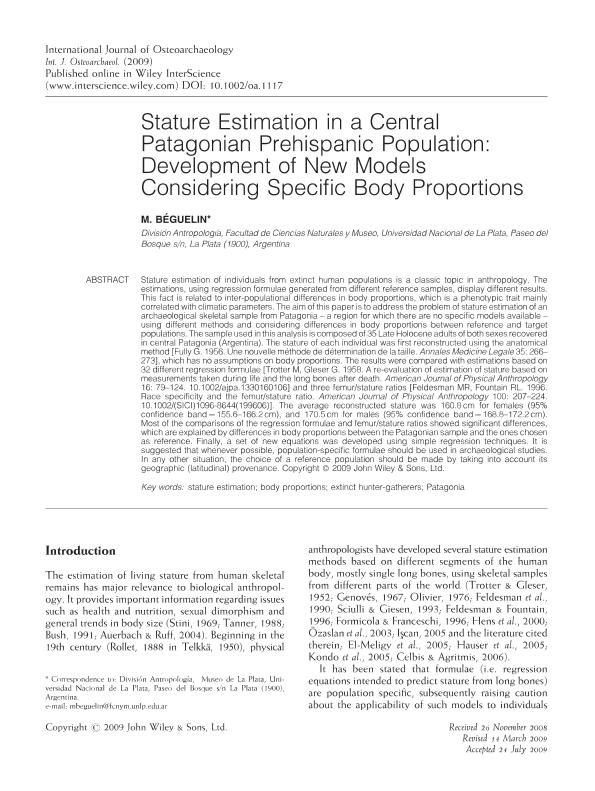Mostrar el registro sencillo del ítem
dc.contributor.author
Beguelin, Marien

dc.date.available
2020-04-13T16:06:40Z
dc.date.issued
2011-03
dc.identifier.citation
Beguelin, Marien; Stature estimation in a central Patagonian prehispanic population: Development of new models considering specific body proportions; Wiley; International Journal of Osteoarchaeology; 21; 2; 3-2011; 150-158
dc.identifier.issn
1099-1212
dc.identifier.uri
http://hdl.handle.net/11336/102379
dc.description.abstract
Stature estimation of individuals from extinct human populations is a classic topic in anthropology. The estimations, using regression formulae generated from different reference samples, display different results. This fact is related to inter-populational differences in body proportions, which is a phenotypic trait mainly correlated with climatic parameters. The aim of this paper is to address the problem of stature estimation of an archaeological skeletal sample from Patagonia - a region for which there are no specific models available - using different methods and considering differences in body proportions between reference and target populations. The sample used in this analysis is composed of 35 Late Holocene adults of both sexes recovered in central Patagonia (Argentina). The stature of each individual was first reconstructed using the anatomical method [Fully G. 1956. Une nouvelle me´thode de de´termination de la taille. Annales Medicine Legale 35: 266-273], which has no assumptions on body proportions. The results were compared with estimations based on 32 different regression formulae [Trotter M, Gleser G. 1958. A re-evaluation of estimation of stature based on measurements taken during life and the long bones after death. American Journal of Physical Anthropology 16: 79-124. 10.1002/ajpa.1330160106] and three femur/stature ratios [Feldesman MR, Fountain RL. 1996. Race specificity and the femur/stature ratio. American Journal of Physical Anthropology 100: 207-224. 10.1002/(SICI)1096-8644(199606)]. The average reconstructed stature was 160.8 cm for females (95% confidence band = 155.6-166.2 cm), and 170.5 cm for males (95% confidence band = 168.8-172.2 cm). Most of the comparisons of the regression formulae and femur/stature ratios showed significant differences, which are explained by differences in body proportions between the Patagonian sample and the ones chosen as reference. Finally, a set of new equations was developed using simple regression techniques. It is suggested that whenever possible, population-specific formulae should be used in archaeological studies. In any other situation, the choice of a reference population should be made by taking into account its geographic (latitudinal) provenance.
dc.format
application/pdf
dc.language.iso
eng
dc.publisher
Wiley

dc.rights
info:eu-repo/semantics/openAccess
dc.rights.uri
https://creativecommons.org/licenses/by-nc-sa/2.5/ar/
dc.subject
stature estimation
dc.subject
body proportions
dc.subject
extinct hunter-gatherers
dc.subject
Patagonia
dc.subject.classification
Otras Humanidades

dc.subject.classification
Otras Humanidades

dc.subject.classification
HUMANIDADES

dc.title
Stature estimation in a central Patagonian prehispanic population: Development of new models considering specific body proportions
dc.type
info:eu-repo/semantics/article
dc.type
info:ar-repo/semantics/artículo
dc.type
info:eu-repo/semantics/publishedVersion
dc.date.updated
2020-04-08T18:13:28Z
dc.identifier.eissn
1047-482X
dc.journal.volume
21
dc.journal.number
2
dc.journal.pagination
150-158
dc.journal.pais
Reino Unido

dc.description.fil
Fil: Beguelin, Marien. Universidad Nacional de La Plata. Facultad de Cienicas Naturales y Museo. División Antropología; Argentina. Consejo Nacional de Investigaciones Científicas y Técnicas. Centro Científico Tecnológico Conicet - La Plata; Argentina
dc.journal.title
International Journal of Osteoarchaeology
dc.relation.alternativeid
info:eu-repo/semantics/altIdentifier/url/https://onlinelibrary.wiley.com/doi/abs/10.1002/oa.1117
dc.relation.alternativeid
info:eu-repo/semantics/altIdentifier/doi/http://dx.doi.org/10.1002/oa.1117
Archivos asociados
